Growing up, the artist Phyllida Barlow, who has died aged 78, was warned by her mother against trading on her illustrious ancestry. Her father’s family tree was decked with Huxleys and Wedgwoods, but it was another of his forebears that her mother had particularly in mind. Barlow was the great-great-granddaughter of Charles Darwin.
“In the 1960s, when I went to Chelsea College of Art, there was quite a socialist approach,” Barlow mildly recalled. “Anything that smacked of privilege was more of a hindrance than a thing to be bragged about. I became rather inhibited by the association.” It was an inhibition that was to shape her as a sculptor.
When, in 2017, Barlow unveiled her work folly in the British Pavilion at the Venice Biennale, critics were transfixed by its mess. A confection of carefully contrived flotsam and jetsam, folly’s papier-mache lollipops and abstract expressionist doors tumbled out of the pavilion and into the gardens beyond. The work’s unwillingness to be contained reflected a parallel refusal to be defined. “In the past,” Barlow noted, “sculpture had historical narratives. It was dominated by the plinth, it monumentalised and celebrated individuals.” One of those, often enough, was Darwin. Bound up in folly’s rejection of a sculptural ancestry was its maker’s renunciation of her own.
Venice marked both a high point in Barlow’s career, and – she was 73 at the time – a late flowering of it. Even a decade before, the idea that she might one day be the Biennale’s official British artist would have been unthinkable. For more than four decades of her career, Barlow had had no gallery and shown almost no work. This, too, fed into the aesthetic of her art. While other British sculptors of her generation – Antony Gormley, say, or Richard Deacon – made sculpture that was traditional in being durable, Barlow quietly cornered the market in an art that was evanescent.

One early piece, made in the 70s in the basement studio of her north London house, was Tent: a sculpture consisting of a sheet of canvas thrown over a wooden frame and then heavily painted. “It provoked absolute hostility,” Barlow recalled, merrily. “It never went on exhibition. I remember two former students from the Slade saying it would be best to throw it away.”
This was followed, in the 80s and 90s, by guerrilla sculptures, illicitly installed in north London school playgrounds, abandoned houses and a defunct stocking factory. Still others were shown in the homes of friends. Sometimes, at night, Barlow would throw objects she had made into the Thames, these sculptural performances having, as she said, “an audience of one”.
The inspiration behind all of these she attributed to her paternal grandmother. It was thus from Nora Darwin (the botanist and geneticist Nora Barlow), rather than Nora’s grandfather, Charles, that Phyllida liked to trace her descent. “Her understairs cupboard was filled with beautifully folded brown paper,” she recalled. “Navy blue sugar paper that grocers used, and neatly assembled piles of reusable stuff such as black rubber bands and old matchboxes. We continued to use Christmas decorations made during the wartime years well into the 50s – strange, rather abject pieces of cardboard with paint on them.”
The virtue of such frugality was lost in the materialism of the 60s and the greed-is-good decades that followed. This infected the art world as much as any other: the expensive, high-gloss hardness of Jeff Koons will stand as testament to the time. It was only with the change of millennium and rise of environmentalism that ideas of sculptural fragility began at last to gain currency.
Barlow’s folly, made of cheap and recycled materials and looking as though it might fall apart at any moment, was absolutely of its day. The neoclassical pavilion in which it stood had been built in 1909, at the height of Britain’s imperial power. The year before folly, to Barlow’s despair, the UK had voted to leave the European Union. Standing in a once-great and now sinking imperial city, her work, and its name, seemed to meditate on the repeated vanities of history.
Phyllida was the daughter of Biddy (nee Brigit Hope Black) and Erasmus Barlow. Her father was an eminent psychiatrist who was in Newcastle researching wartime brain trauma when Phyllida, his third and last child, was born there.
The family moved to London and at Chelsea, aged 18, she met Fabian Peake, son of the novelist Mervyn. In 1966 she married him, moving on in the same year to study at the Slade School of Fine Art and, later, to teach there. When the couple’s first child, Florence, was born in 1973, Barlow gave up work. Child-rearing and making art were, she said, “completely incompatible. That’s not meant to be cruel or regretful. Both are creative. But the minute one works at home, there’s a collision.”
Four more children – Clover, Tabitha and twins, Eddie and Lewis – followed in the next eight years. (All would become artists of various stripes.) It was only in her 40s that Barlow returned to teaching, first in Bristol, then at Brighton, Camberwell, and finally back at the Slade. She would stay at the school until retiring as a professor there in 2009. Then came a visit from Hauser & Wirth, the king-making Swiss gallerists. If Barlow’s work had remained below the radar for 40 years, her fame as a thinker and teacher had not. Among artists she had taught at the Slade were Rachel Whiteread, Tacita Dean and Martin Creed, all, by 2010, much more famous than she was. It was from these ex-students that Iwan Wirth heard Barlow’s name.
That year, he visited her in the famously messy suburban house in Finsbury Park, north London, where she and Peake had raised their family. “I couldn’t believe this was where she lived,” Wirth recalled. “My driver said: ‘I don’t think that that can be it.’ And then we are in this extraordinary house, which Phyllida explains she doesn’t clean, ever. It was like therapy for the Swiss soul, the opposite of what we were brought up with. We knew immediately that she was vintage Hauser & Wirth.”
Fame came quickly. In the year of Wirth’s visit, Barlow had a joint show with the Iranian sculptor Nairy Baghramian, at the Serpentine Gallery in London. The following year, she was belatedly made a Royal Academician, in 2015 a CBE and in 2021 a dame. In 2014, her installation dock, in Tate Britain’s echoing Duveen Galleries, wowed critics, many of whom, five years before, had never heard of her.
Like folly, dock countered the marbled vastness of the space in which it stood with an insistent anti-monumentalism of its own. Tate Britain seemed to have been hit by a tsunami that had left behind it wooden pallets, bits of piping and old painted doors that happened to have arranged themselves into sculptural forms. And there were hoardings – a source of particular fascination to Barlow, their film-set thinness exposing the false solidity of architecture such as the Duveen Galleries’.
The new century, Barlow thought, had been defined not by monuments but by falling monuments: the destruction of the World Trade Center in 2001, the toppling of the statue of Saddam Hussein in Firdos Square in 2003.
Aesthetically, these were things to be mourned and celebrated. “In the collapse of a monument, there is a tragedy, a triumph, a beauty, and also an immense grief,” Barlow said. As to her own work, she mused, “I love big sculpture, that sense of my own physicality being in competition with something that has no rational need to be in the world at all. And I think that is in itself just an expression of the human condition, of who we are and what we are.”
Barlow is survived by her husband and children.
(Gillian) Phyllida Barlow, sculptor, born 4 April 1944; died 12 March 2023


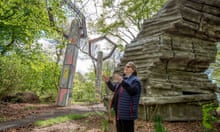
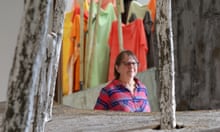
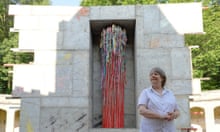
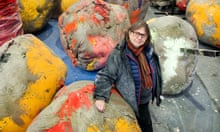

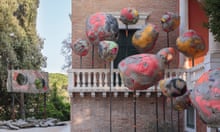
Comments (…)
Sign in or create your Guardian account to join the discussion